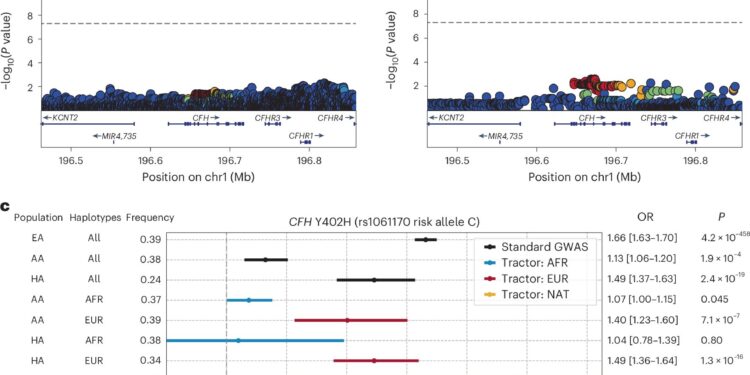Local ancestry analysis of the CFH and ARMS2/HTRA1 loci. Credit: Natural genetics (2024). DOI: 10.1038/s41588-024-01764-0
Age-related macular degeneration (AMD), which affects approximately 200 million people worldwide and can lead to legal blindness, impairs an area of the eye (retina) used for reading, driving, and many other critical daily tasks.
A new study using large datasets of existing patients points to genetic and demographic factors that increase the risk of developing AMD.
In the study, recently published in Natural geneticsa team of scientists worked with the VA Office of Research and Development’s Million Veteran Program (MVP), a large biobank of veterans recruited from more than 60 U.S. Department of Veterans Affairs (VA) medical centers nationwide , to examine the demographics, lifestyle, clinical and genetic risk profiles of AMD.
Their study focused on more than 287,000 veterans enrolled in MVP and integrated the results with results from several other independent biobanks to define the largest study of genetic risk for AMD and the first to include ancestry populations diverse.
“An important aspect of our study is the inclusion of veterans of African or Hispanic ancestry in MVP, groups that have not been well studied in previous genetic studies of AMD,” said Sudha Iyengar, professor and vice chair for research in the Department of Population and Quantitative Health Sciences at Case Western Reserve University School of Medicine.
“This diverse population provides a unique resource for identifying clues to develop treatments for AMD, a disease for which few effective treatments are available.”
The collective human genome shared by all of the world’s ancestral groups contains discrete signatures indicating a higher risk of AMD among people of European ancestry, compared to those of African or Hispanic ancestry.
“By increasing the size of the population studied,” Sudha said, “the research provided additional information to identify genetic markers with more modest but potentially important biological contributions to the likelihood of an individual developing or not developing AMD The study also discovered an increased number of genes linked to AMD, from 34 previously identified to 60.”
They also confirmed previous beliefs that a history of smoking or alcohol use increases the risk of developing AMD. Although approximately 90% of MVPs are male enrollees, the researchers were able to confirm previous observations that women are more susceptible to AMD than men.
Sudha co-led the research with the late Robert Igo Jr., Dana Crawford and Jessica Cooke Bailey of the School of Medicine. They collaborated with Neal Peachey, associate chief of staff for research at the VA Northeast Ohio Health System and professor of ophthalmic research at the Cleveland Clinic Cole Eye Institute.
The study involved scientists from several VA medical centers, including Bryan Gorman and Saiju Pyarajan (both of the VA Boston Healthcare System), Christopher Halladay and Wun-Shieh Wu (both of the Providence VA Medical Center), and Pannos Roussos and Georgios Vodulakis (both of Mount Sinai and Bronx VA), “who played a key role in integrating data from multiple health systems, cohorts, and data types to create new knowledge about the biology of AMD,” Sudha said.
More information:
Bryan R. Gorman et al, Genome-wide association analyzes identify distinct genetic architectures for age-related macular degeneration across ancestors, Natural genetics (2024). DOI: 10.1038/s41588-024-01764-0
Provided by Case Western Reserve University
Quote: US study of veterans helps identify genetic risks of age-related macular degeneration (January 14, 2025) retrieved January 14, 2025 from
This document is subject to copyright. Except for fair use for private study or research purposes, no part may be reproduced without written permission. The content is provided for informational purposes only.



